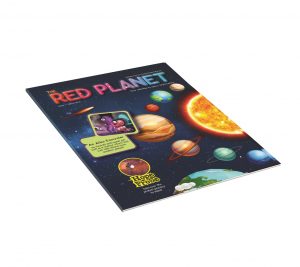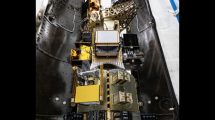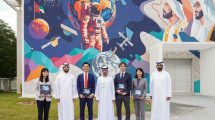 MBRSC is distributing a self-produced magazine dedicated to space and science for children in the UAE, as a part of the Year of Reading initiative. As well as making a contribution to the push for reading, which was announced by His Highness Sheikh Mohammed bin Rashid Al Maktoum, Vice President and Prime Minister of the UAE and Ruler of Dubai, the magazine, named ‘The Red Planet’, has also been produced in line with space centre’s own objective to inspire young people and encourage them to think about STEM (Science, Technology, Engineering and Math) education.
MBRSC is distributing a self-produced magazine dedicated to space and science for children in the UAE, as a part of the Year of Reading initiative. As well as making a contribution to the push for reading, which was announced by His Highness Sheikh Mohammed bin Rashid Al Maktoum, Vice President and Prime Minister of the UAE and Ruler of Dubai, the magazine, named ‘The Red Planet’, has also been produced in line with space centre’s own objective to inspire young people and encourage them to think about STEM (Science, Technology, Engineering and Math) education.
The Red Planet is distributed across the UAE to the nation’s libraries and schools, and has even formed part of student extra-curricular reading activities, as encouraged by the Year of Reading. The magazine also targets spreading the concepts of innovation, creativity and imagination among the future generations, three key components that will help the UAE continue its development for generations to come.
Commenting on the magazine, His Excellency Yousuf Hamad Al Shaibani, Director General of MBRSC, said: “In line with our attempt to promote knowledge among students, who are the centre of development and our future-building tool, we will not hesitate in contributing to helping them in realising their potential in terms of science and knowledge and providing them with the skills that will enable them to contribute to the development of our country in the coming years.
“The Red Planet magazine is one of our long-term educational projects, aimed at spreading knowledge and making reading a daily habit. The magazine aims to enrich the younger generation’s knowledge of space science, complementing the role of the school and family. It has contributed to the implementation of The Reading Challenge Programme, launched by His Highness Sheikh Mohammed bin Rashid Al Maktoum, with a view to creating a generation full of readers and knowledgeable thinkers who are interested in building a career in the scientific sectors.”
Al Shaibani concluded: “We share, with the Ministry of Education and Ministry of Higher Education, the objectives of transferring knowledge, promoting innovation and building a new generation interested in science.”
Mona Al Qemzi, the Assistant Director General for Administrative and Financial Affairs at MBRSC and Managing Editor of The Red Planet said: “We have been inspired by the message of His Highness Sheikh Khalifa bin Zayed Al Nahyan, the President of the UAE, as he said: ‘The key to prosperity will always be knowledge and the key to knowledge will always be reading’, and Sheikh Mohammed bin Rashid Al Maktoum, who said: ‘Scientists, thinkers, researchers and innovators who are leading our future do not come down from the sky; rather they erect their high stature from the ground up, where the most powerful soil that nurtures them is their love for reading and a passion for gaining knowledge’.
“We are participating in building a new generation armed with a love of reading from an early age by introducing a magazine for children and young people across the UAE, presented in a professional style that inspires. The magazine makes learning a fun trip, rich in science and knowledge, crowned by literature addressing imagination and transferring information through the illustrated stories and scientific tales, written to be ultimately engaging.”
Al Qemzi added: “The Red Planet magazine features a simple language, creative pictures and innovative designs and drawings depicting space facts and the latest scientific discoveries, and it encourages reading and stimulates innovation.”
More than 16,000 copies of the Red Planet magazine were distributed in October to the UAE’s public schools, in accordance with an agreement between MBRSC and the Ministry of Education.
“We print 50,000 copies of each issue and distribute them directly to the model and private schools under an integrated distribution plan,” Al Qemzi added.
Due to the scarcity of Arabic publications on scientific culture and science fiction for children, adolescents and youth, Al Qemzi declared that: “We decided to proceed with the magazine project, which is a time consuming and creative process that also requires innovation, creativity, and funding. But the need to reinstall reading as a priority for our young generations is critical to MBRSC. The content is not simply text accompanied by images, it contains scientific stories that engage the child’s mind. We have created cartoon characters, drawings, unique graphics, and recurring adventure stories, all of which aim to overcome the challenge of weak interest in reading in the digital age.”
Al Qemzi added: “The magazine derived its name from the biggest and most ambitious space projects entrusted to MBRSC: The Emirates Mars Mission Hope Probe, which will study the Red Planet’s atmosphere. The name came after prolonged discussions and studies about the magazine’s approach, including defining the idea, concept, goals and points that should be avoided and those that should be followed to win the children’s confidence and encourage them to read each and every issue of the magazine.
“The magazine has been very well received, and has been greatly appreciated by the children in particular. We’ve also received significant support from parents, educational and cultural organisations, encouraging us to continue and grow. I believe that The Red Planet magazine has and continues to fulfill our objective of introducing space science and astronomy, and inspiring children to study engineering and science in accordance with the requirements and best practices of child oriented journalism,” Al Qemzi concluded.
The Red Planet is a space magazine made for youngsters and school students from the age of 6 to 14. It is issued every two months in both the Arabic and English languages, with the aim of motivating children to read, while supporting the UAE’s strategic plans, which aim to inspire children to study science and adopt innovative thinking, in line with the national strategy for innovation and the vision of building an economy based on knowledge.
The magazine’s motif is “Your gateway to space exploration”, and it does indeed provide an entry point to the discovery of space, featuring facts and information about planets, galaxies, astronauts’ adventures, and relevant scientific discoveries, as well as the latest news on the Hope Probe and it’s scheduled journey to Mars.
So far, the space centre has published four consecutive issues of the magazine, the first last March, and then in May, July, and September. Up until now the magazine has seen the distribution of 200,000 free copies to public and private schools to ensure it is accessible by the targeted students and children and to make scientific reading a daily habit from early age. There are 50,000 copies of the fifth issue of the magazine scheduled to be distributed in November, a figure which will see the overall number of copies reach 250,000 during the Year of Reading. The magazine is also distributed to a number of model schools, science clubs and talent centres for children, as well as displayed at conferences and exhibitions.












Add Comment